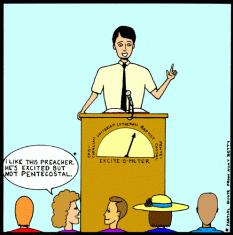
English: The Wisdom of Solomon, by James Jacques Joseph Tissot (French, 1836-1902) (Photo credit: Wikipedia)
The wisdom of Solomon (not meaning, the ancient book by that name) is something of an ambiguity. And perhaps that is the nature of wisdom, recognizing ambiguities and trying to steer the right course. Take another look at the all-too-familiar first demonstration of Solomon’s wisdom: 1 Kings 3:16-27: *
Some time later two prostitutes came to the king to have an argument settled.
“Please, my lord,” one of them began, “this woman and I live in the same house. I gave birth to a baby while she was with me in the house. Three days later this woman also had a baby. We were alone; there were only two of us in the house. “But her baby died during the night when she rolled over on it. Then she got up in the night and took my son from beside me while I was asleep. She laid her dead child in my arms and took mine to sleep beside her. And in the morning when I tried to nurse my son, he was dead! But when I looked more closely in the morning light, I saw that it wasn’t my son at all.”
Then the other woman interrupted, “It certainly was your son, and the living child is mine.” “No,” the first woman said, “the living child is mine, and the dead one is yours.” And so they argued back and forth before the king.
Then the king said, “Let’s get the facts straight. Both of you claim the living child is yours, and each says that the dead one belongs to the other. All right, bring me a sword.” So a sword was brought to the king. Then he said, “Cut the living child in two, and give half to one woman and half to the other!”
Then the woman who was the real mother of the living child, and who loved him very much, cried out, “Oh no, my lord! Give her the child — please do not kill him!” But the other woman said, “All right, he will be neither yours nor mine; divide him between us!” Then the king said, “Do not kill the child, but give him to the woman who wants him to live, for she is his mother!” (1 Kings 3:16-27 NLT)
We think we know this story, but do we? Let’s have another look.
First, there are two “prostitutes” implying these women should be put to death themselves (according to Torah – see the proscriptions against sex outside of marriage in Lev.20:10-16) and not simply have a dispute settled. Does “wisdom” pertain to knowing when not to apply torah? We are also intentionally given this detail to cause us to question their character (and thus whatever they might say) from the beginning.
Second, to help clarify some details let’s label these women “A” and “B”. “A” is the prostitute who claims to have had her live newborn switched in the night for prostitute “B”s dead baby. “B” claims that the dead infant was indeed “A”s baby, and thus that “A” is lying. Our problem is that we tend to believe the first one to speak (“The first to speak in court sounds right…” Proverbs 18:17a), but forget that there is always more to the story (“…until the cross-examination begins” Proverbs 18:17b). We seem to automatically act unwisely in such readings where we have given the benefit of the doubt to the first claimant (A) and denied the words of the second (B). So how could one wisely discern who is speaking the truth, especially when the character of both is questionable (at best)?
Third, Solomon’s answer is to kill the living baby and give half to each of these women (both of whom are themselves actually worthy of death). We acclaim Solomon for his “wisdom” in this because it seems apparent to us that this makes it clear who the real mother was. But the ambiguity of wisdom is that Solomon did not really know how these unsavory women would respond and his only answer appears to be a death sentence to the baby. A strange “wisdom” if you ask me.
Fourth, note the ambiguity of the text where neither “A” nor “B” is identified as either woman: the one willing to have the baby cut asunder and the one wanting the baby to survive if even as the child of the other woman. The text does not clarify for us which woman said what. It uses the terms “the real mother of the living child, and who loved him very much” contrasted with “the other woman”. This calls for wisdom (with all its shades of ambiguity). It is apparent to the writer that the “mother” is not simply the “mother”, but also “loved” the child “very much”. The portrayal is of one who indeed is the mother (according to the narrator) and whom Solomon chooses because this woman “wants him to live” and thus (at least functionally) would be “his mother”.
So what is wisdom and where is it required? In the ambiguous moments where one is uncertain and needs to know what to do and how to do it. It is certainly not a “clear” way, but the way that demands that we ask of God for it (1 Kings 3:10-11; James 1:5).
_______________________
* See the helpful analysis of this account in Richard S. Briggs, The Virtuous Reader: Old Testament Narrative and Interpretive Virtue (Studies in Theological Interpretation; Grand Rapids, MI: Baker Academic, 2010). It was Briggs work that first alerted me to note these ambiguities in this wisdom text.




 The History Channel is releasing
The History Channel is releasing


Jesus Led Israel Out of Egypt?
He mentioned Jude 5 which reads:
Talk about a strange reading of the Exodus account! (Origen would be proud 😉 ). So I went to look it up in my NA27 and discovered an overwhelming manuscript support for the reading “Jesus” (A B 33. 81. 322. 323. 424c. 665. 1241. 1739. 1881. 2298. 2344. Vulgate, Coptic (Bohairic, Sahidic), Ethiopic. Origen, Cyril, Jerome, Bede; “the Jesus” 88. 915) over “[the] Lord” (K Maj.).* Not only is the textual support overwhelmingly in support of such a reading, but the probability is overwhelmingly in favor of an original “Jesus” being changed to “Lord” (rather than vice versa). Who would think of changing “Lord” to “Jesus”? It would seem to make things more defensible (for reading the OT as it was intended by its original human author) with reading “Lord” in light of the OT, but “Jesus” offers a sharply Christological reading of the Hebrew scriptures (which fits Jude’s overall agenda). Even Bruce Metzger’s A Textual Commentary on the Greek New Testament (ABS, 1994, p.657) has an extended bracketed discussion of this issue suggesting that the reading “Lord” really does not appear original in any sense. And yet, the UBS4 and NA27 texts maintained κύριος (“Lord”) in the main text. I don’t have access to NA28, but I would be curious to know if they’ve continued this strange tradition.
Incidentally, some English translations actually have “Jesus” (ESV, NET, NLT; and the Latin Vulgate)** in their primary text despite the preference for “Lord” in these two critical Greek texts (which are knowingly nearly identical) which typically form the basis for English translations (not that there aren’t plenty of times where the translators chose a different variant, but this one is rather fascinating).***
To me, the most significant (and fascinating) thing I was reminded of in my searching through the evidence and the translations, was that it appears issues of congruity for English readers often drives translations against where the textual evidence may actually point (one of the reasons I quite like the NET for boldly trying to follow the original text closely…at least at times).
So what are your thoughts on a variant like this and the need to translate what is considered the “best” (or most appropriate?) text?
_________________
* To be fair there are a number of other lesser attested readings which are not supported well by either internal or external criteria.
** The ESV footnotes “some manuscripts” having “Lord”; the NLT says: “As in the best manuscripts; various other manuscripts read the Lord, or God, or Christ; one reads God Christ.” The NET reads:
*** Those translations offering “Lord” are KJV, NAB, NASB, NIV(1984, 2010), NJB, NKJV, NRSV, TNIV. The NAB footnotes that “manuscripts vary”; the NASB only mentions “two early mss” mentioning “Jesus”; the NIV tradition has “some early manuscripts” reading “Jesus”; and the NRSV has “Other ancient authorities read though you were once for all fully informed, that Jesus (or Joshua) who saved.”